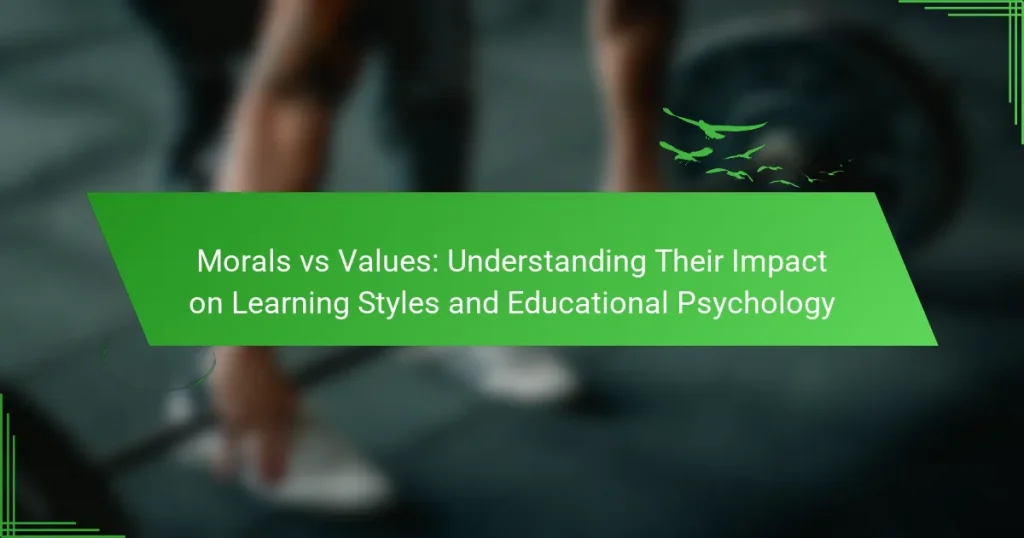Understanding the differences between morals and values is crucial for enhancing educational outcomes. Morals guide ethical decision-making, while values shape motivation and learning styles. This article explores their impact on student engagement, the role of cultural context, and strategies for aligning teaching methods with diverse learning preferences. By recognising these distinctions, educators can create more effective and inclusive learning environments.

What are the key differences between morals and values in educational psychology?
Morals and values differ significantly in educational psychology. Morals are often seen as universal principles guiding right and wrong, while values are individual beliefs that shape personal behaviour and choices.
Morals influence ethical decision-making in learning environments, promoting integrity and respect. Values shape a student’s motivation and engagement, impacting their learning styles. For example, a student valuing collaboration may thrive in group settings, while one prioritising independence may excel in solitary tasks.
Understanding these distinctions helps educators tailor their approaches, fostering environments that align with students’ moral frameworks and personal values. This alignment can enhance educational outcomes and support diverse learning needs.
How do morals influence learning styles?
Morals significantly influence learning styles by shaping attitudes and behaviours towards education. Individuals with strong moral frameworks often engage in collaborative learning, valuing community and shared knowledge. This contrasts with those who may prioritise individual achievement, reflecting different educational approaches. For example, students who emphasise integrity may prefer group projects, fostering teamwork and ethical discussions. As a result, understanding these moral influences can enhance educational psychology, tailoring teaching methods to align with students’ values.
What role does cultural context play in moral development?
Cultural context significantly influences moral development by shaping values and ethical perceptions. Cultural norms dictate what is considered right or wrong, affecting individual learning styles. For example, collectivist cultures emphasise community values, fostering cooperation, while individualistic cultures prioritise personal achievement. This variation impacts educational psychology, as teaching methods must align with cultural values to enhance moral reasoning and decision-making. Understanding these dynamics is essential for educators to support diverse learners effectively.
How can educators integrate morals into teaching practices?
Educators can integrate morals into teaching practices by embedding ethical discussions within the curriculum. This approach fosters critical thinking and promotes moral development among students.
Incorporating real-world scenarios can illustrate moral dilemmas, encouraging students to analyse and debate ethical implications. This method enhances engagement and deepens understanding of moral concepts.
Utilising collaborative projects allows students to practice moral reasoning in group settings. They learn to respect diverse perspectives, which cultivates empathy and social responsibility.
Assessment methods should also reflect moral education, evaluating not only academic performance but also ethical reasoning and behaviour. This holistic approach reinforces the importance of morals in the learning process.
What impact do values have on student motivation?
Values significantly influence student motivation by shaping their goals and attitudes towards learning. When students align their personal values with educational objectives, they exhibit higher engagement and persistence. For instance, intrinsic values, such as a passion for knowledge, often lead to better academic performance. Conversely, misalignment between personal values and educational expectations can result in disengagement. Understanding this dynamic helps educators tailor strategies that enhance motivation by fostering a values-driven learning environment.
Which values are most commonly emphasized in UK educational settings?
In UK educational settings, values such as respect, responsibility, and integrity are most commonly emphasised. These values foster a positive learning environment and support students’ social and emotional development. Schools often integrate these principles into their curricula and daily interactions, promoting a culture of inclusivity and collaboration. Respect for diversity and individual differences is particularly highlighted, encouraging students to appreciate various perspectives.
How do personal values affect learning preferences?
Personal values significantly influence learning preferences by shaping motivation, engagement, and the choice of learning methods. Individuals with strong intrinsic values tend to prefer experiential learning, while those valuing extrinsic outcomes may favour structured environments. Values also affect the perception of relevance in educational content, guiding learners towards subjects that resonate with their beliefs. Understanding this connection is crucial for educators to tailor approaches that align with students’ moral frameworks, enhancing their educational experience.

What are the universal attributes of morals and values in education?
Morals and values in education universally promote ethical behaviour, critical thinking, and social responsibility. These attributes shape learning environments and influence student engagement. A unique attribute is the role of cultural context, which impacts how morals and values are interpreted and taught. Additionally, morals guide decision-making, while values provide motivation for learning, creating a holistic educational experience.
How do morals and values shape classroom dynamics?
Morals and values significantly influence classroom dynamics by shaping student interactions and learning environments. Morals often dictate acceptable behaviour, while values drive individual motivations. For instance, a classroom that emphasises respect fosters collaboration and open dialogue. In contrast, differing values can lead to conflict or disengagement. Educational psychology highlights that understanding these influences aids in tailoring teaching strategies to enhance learning outcomes. Engaging students’ moral and value systems can promote a more inclusive and effective educational experience.
What are the unique characteristics of values in different learning styles?
Values in different learning styles exhibit unique characteristics that influence educational outcomes. Visual learners often value clarity and organisation, while auditory learners prioritise verbal explanations and discussions. Kinesthetic learners appreciate hands-on experiences and practical applications. Each style shapes how individuals perceive and engage with morals, affecting their ethical decision-making and personal growth. Understanding these distinctions enhances tailored educational approaches.

What rare attributes exist in the intersection of morals, values, and learning styles?
Rare attributes at the intersection of morals, values, and learning styles include individual ethical frameworks, cultural influences on value systems, and adaptive learning preferences. These attributes shape how students engage with educational content and interact with peers. Understanding these nuances enhances educational psychology and promotes tailored learning strategies.
How can understanding these attributes enhance educational outcomes?
Understanding morals and values enhances educational outcomes by aligning teaching methods with students’ learning styles. This alignment fosters engagement and motivation, leading to improved academic performance. For instance, recognising the unique attribute of a student’s moral framework can inform personalised approaches that resonate with their values. As a result, educators can create a supportive environment that nurtures both cognitive and emotional development, ultimately enhancing overall educational success.

What strategies can educators use to align morals and values with diverse learning styles?
Educators can align morals and values with diverse learning styles by integrating culturally relevant pedagogy, promoting social-emotional learning, and utilising differentiated instruction. Culturally relevant pedagogy respects students’ backgrounds, fostering engagement. Social-emotional learning enhances moral development, while differentiated instruction tailors teaching methods to individual learning preferences. This approach supports the unique attributes of each learner, ensuring a holistic educational experience.
What best practices can be implemented for effective moral education?
Effective moral education can be achieved through various best practices that enhance student engagement and understanding. Incorporating experiential learning, such as community service, allows students to apply moral concepts in real-life situations. Additionally, fostering open discussions about ethical dilemmas encourages critical thinking and personal reflection. Integrating diverse perspectives helps students appreciate the complexity of moral issues. Finally, modelling ethical behaviour by educators reinforces the importance of morals in daily life.
What common mistakes should educators avoid when addressing morals and values in learning?
Educators should avoid oversimplifying morals and values, as this can lead to misunderstandings. Failing to recognise the complexity of these concepts can hinder students’ ability to engage critically. Additionally, neglecting diverse perspectives may alienate students, reducing inclusivity in discussions. Lastly, not integrating real-life applications can make lessons feel irrelevant, diminishing students’ motivation to internalise these principles.




